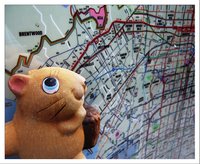Big Blue Bus, Line 5 – 26th Street

Some people drive cars. Some people plant trees. Some people make art.
This car, formerly known as a Mercedes, is now decorating the entrance to the
Santa Monica Museum of Art at
Bergamot Station. It is one of four “Junker Garden” cars created by
Farmlab, the thinktank/performance venue/art group which evolved out of the
Not a Cornfield project.
The this junker garden was the center of today's
Cause for Creativity: Arbor Ardor event.
Inspired by the 2006 eviction of the
South Central Farmers from their community garden, the Junker Gardens evolved as a way to bring the garden back to the city. Farmlab realized that constructing mobile or container gardens would cost a fraction of the $16.3 million demanded (and, subsequently, refused) by Ralph Horowitz to repurchase the 14 acres in South Central that once constituted one of the nation’s largest urban gardens.

With a car, some space, some soil, and a few days, Farmlab explained how to build your own self-contained car garden. Although you can’t exactly drive it, it can still be towed, pushed, or dragged from place to place.
Volunteers from
TreePeople were on hand, showing kids and parents the essentials of tree planting, but, unfortunately, not planting any actual trees.
Together they created art trees with colored scraps, potted two-by-fours, and staple guns. The colorful garden grew throughout the afternoon with the help of children's hands.

The objective was to expose the groups of children to art, the process of creation, and the idea of growth. The hope was to inspire the kids to look at nature, see what can be created, and plant the seeds of art and arbor ardor (too much alliteration?) in them.
While fun, I still prefer actual trees. It would have been exciting to gut, decorate and plant old toy cars with real plants that the kids could take home.
As a young squirrel, I once visited TreePeople and planted little pine tree seedlings in old milk cartons. That day I learned that even little me could create and be responsible for something living. Something that could very well out-live me.

TreePeople is still doing plantings like this at their Coldwater Canyon nursery. One day I will try to venture up the canyon to join them again (it’s a long walk).
At the end of the day, the
City of Santa Monica Environmental Programs Division spread the word about the green living and business workshops they offer, and offered printed copies of the
City of Santa Monica Environmental Directory for all attendees.
It was a sunny, colorful day filled with art and laughter and thoughts. Although I was the only one leaving Bergamot Station without a car.
 This weekend I visited the 23rd Annual UCLA Pow Wow.
This weekend I visited the 23rd Annual UCLA Pow Wow.  On the less traditional side, there were a few booths, with companies like Full Blood Skates which are bringing a different look and stronger feel to tribal pride. It's nicer to see than the End of the Trail images.
On the less traditional side, there were a few booths, with companies like Full Blood Skates which are bringing a different look and stronger feel to tribal pride. It's nicer to see than the End of the Trail images.







































